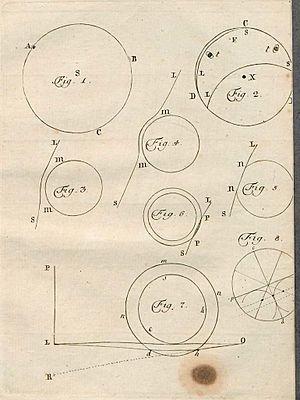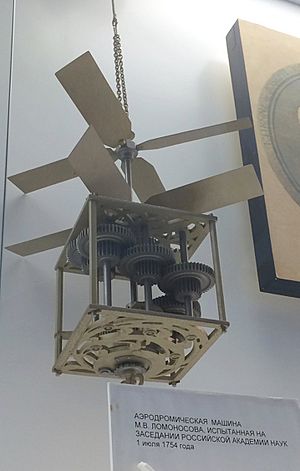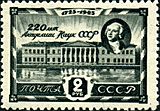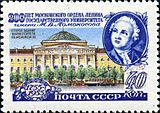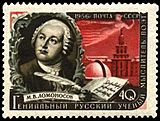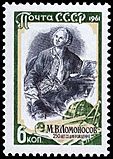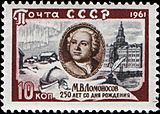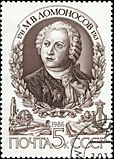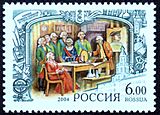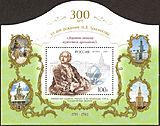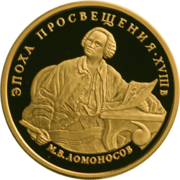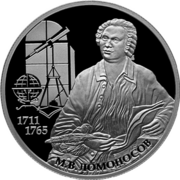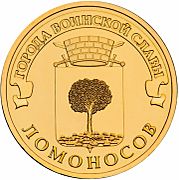Mikhail Lomonosov facts for kids
Quick facts for kids
Mikhail Lomonosov
|
|
|---|---|
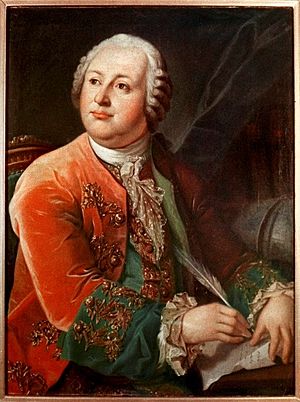
Portrait by G. Prenner, 1787
|
|
| Born |
Mikhail Vasilyevich Lomonosov
19 November 1711 Mishaninskaya, Archangelgorod Governorate, Tsardom of Russia
|
| Died | 15 April 1765 (aged 53) |
| Nationality | Russian |
| Alma mater | Slavic Greek Latin Academy St. Petersburg Academy University of Marburg |
| Spouse(s) | Elizabeth Christine Zilch |
| Scientific career | |
| Fields | Natural science, Astronomy, chemistry, physics, physical chemistry, geology, geophysics, mineralogy, history, philology, optics |
| Institutions | St. Petersburg Academy |
| Academic advisors | Christian Wolff |
| Signature | |
Mikhail Vasilyevich Lomonosov (/ˌlɒməˈnɒsɒf/; Russian: Михаил (Михайло) Васильевич Ломоносов; 19 November [O.S. 8 November] 1711 – 15 April [O.S. 4 April] 1765) was a very smart and talented Russian scientist and writer. He was like a "Renaissance man" because he was good at so many different things.
Lomonosov made important discoveries in many areas. These included the atmosphere of Venus and the law of conservation of mass in chemical reactions. He worked in natural science, chemistry, physics, mineralogy, history, art, and more. He is also known as the founder of modern geology. Lomonosov was a poet too, and he helped shape the modern Russian literary language.
Contents
Early Life and His Family
Mikhail Lomonosov was born in a small village called Mishaninskaya. This village was later renamed Lomonosovo to honor him. It was in the far north of Russia.
His father, Vasily Dorofeyevich Lomonosov, was a successful fisherman and ship owner. He made money by moving goods between different towns. Mikhail's mother was Elena Ivanovna Sivkova, a deacon's daughter.
Mikhail stayed in his village until he was ten years old. Then, his father wanted him to join the family business. So, Mikhail started going with his father on trading trips.
Mikhail's Passion for Learning
Young Mikhail loved learning much more than business. He was always eager to gain new knowledge. A neighbor, Ivan Shubny, taught him to read when he was a boy. Mikhail spent all his free time reading books.
He continued his studies with the village deacon, S.N. Sabelnikov. For many years, he only had religious books to read. When he was fourteen, he got two important books: a grammar book and an arithmetic book. These books helped him a lot.
In 1724, his father married for the third time. Mikhail did not get along well with his stepmother, Irina. He was unhappy at home and really wanted a better education. Since he couldn't get it in his village, he decided to leave.
His Education Journey
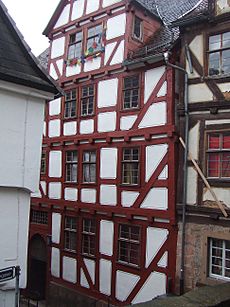
In 1730, when he was nineteen, Lomonosov walked all the way to Moscow. He wanted to "study sciences." He got into the Slavic Greek Latin Academy by pretending to be the son of a nobleman. Later, this lie almost got him kicked out, but he was lucky and stayed.
Lomonosov lived on very little money, eating only black bread and kvass. But he learned very quickly. Some people believe he went to Kiev for a short time in 1735 to study. However, he wasn't happy with the education there and soon returned to Moscow.
In just five years, Lomonosov finished a twelve-year study program. In 1736, he was one of the top 12 students chosen for a scholarship at the St. Petersburg Academy. He studied hard and earned a special grant to study in Germany for four years. He first went to the University of Marburg and then to Freiberg.
Studying Abroad
The University of Marburg was a very important university in Europe. This was because of a famous philosopher named Christian Wolff. Lomonosov studied with Wolff in Marburg from 1736 to 1739. This connection was very important for Lomonosov's life and his ideas about science.
From 1739 to 1740, he studied minerals and philosophy at the University of Göttingen. He also spent more time studying German literature.
Lomonosov quickly learned German. Besides philosophy, he studied chemistry seriously. He also started writing poetry. His poem, Ode on the Taking of Khotin from the Turks, written in 1739, became very popular in Saint Petersburg.
While in Marburg, Lomonosov lived with Catharina Zilch, a widow. He fell in love with her daughter, Elizabeth Christine Zilch, and they got married in 1740. It was hard for Lomonosov to support his family with the small amount of money he received from the Russian Academy of Sciences. So, he got permission to return to Russia.
Back in Russia
Lomonosov came back to Russia in June 1741, after almost five years abroad. A year later, he became an Assistant in the physics department at the Russian Academy of Science. In 1743, he was arrested and held for eight months for supposedly insulting people at the academy. He was released in 1744 after saying sorry.
In 1745, Lomonosov became a full member of the academy and a Professor of chemistry. He set up the academy's first chemistry laboratory. Lomonosov wanted to make Russia's education better. In 1755, he worked with Count Ivan Shuvalov to create Moscow University.
In 1760, he became a foreign member of the Royal Swedish Academy of Sciences. In 1764, he was named a State Councillor, a high position in the Russian Empire. He passed away on April 15, 1765, in Saint Petersburg. Many people call him the "Father of Russian Science." However, his scientific achievements were not well-known outside Russia until much later.
Science and His Inventions
Physics Discoveries
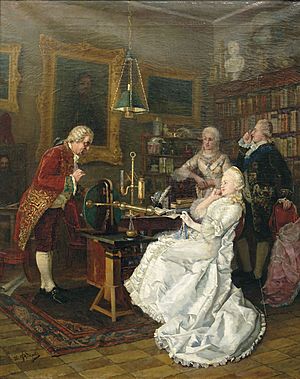
In 1756, Lomonosov did an experiment similar to one by Robert Boyle. He found that a popular idea called the phlogiston theory was wrong. This theory said that things lost a special substance when they burned.
Lomonosov discovered the Law of Mass Conservation. This law states that in a chemical reaction, the total mass of the things you start with is equal to the total mass of the things you end up with. He wrote: "Today I made an experiment... without access of air from outside the mass of the burnt metal remains the same." Lomonosov and Antoine Lavoisier are both known for discovering this law.
He also believed that all matter is made of tiny particles. He called these "corpuscles" (molecules) which are made of "elements" (atoms). He defined an element as a part of a body that cannot be broken down into smaller, different parts.
Lomonosov thought that heat was a form of motion. He also suggested the wave theory of light. He helped develop the kinetic theory of gases. He stated the idea of conservation of matter like this: "All changes in nature are such that as much is taken from one object, so much is added to another."
Astronomy Work
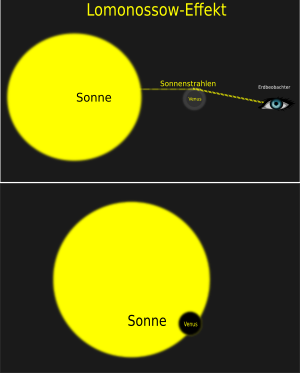
Lomonosov was the first to discover the atmosphere of Venus. He saw it during his observation of the transit of Venus in 1761. This happened at a small observatory near his home in St Petersburg.
In 2012, astronomers used old telescopes to re-create Lomonosov's observation. They found that his telescope was good enough to see the arc of light around Venus. This arc appears when Venus passes in front of the Sun.
In 1762, Lomonosov showed an improved design for a reflecting telescope. His telescope had its main mirror tilted slightly. This made the image focus on the side of the telescope tube. This way, the observer could look through the eyepiece without blocking the light. However, this invention was not published until 1827. So, a similar design by William Herschel became more famous.
Chemistry and Geology
In 1759, Lomonosov and his helper, Joseph Adam Braun, were the first to freeze mercury. They also did early experiments with it. Lomonosov believed that nature is always changing and developing. He showed that soil, peat, coal, petroleum, and amber all come from living things.
In 1745, he made a list of over 3,000 minerals. In 1760, he explained how icebergs are formed.
In 1763, he published On The Strata of the Earth. This was his most important work on geology. This book showed his ideas before James Hutton, who is often called the founder of modern geology. Lomonosov believed that Earth's processes are connected over time. He thought we could understand the planet's past by looking at its present.
Geography Studies
Lomonosov's study of icebergs led to his important work in geography. He came close to the idea of continental drift. He also predicted that Antarctica existed. He argued that icebergs in the South Ocean could only form on land covered with ice.
He invented sea tools that made it easier to write down and calculate directions and distances. In 1764, he planned an expedition to find the Northeast Passage. This route would connect the Atlantic and Pacific oceans by sailing along the northern coast of Siberia.
Mechanical Inventions
Mikhail Lomonosov came up with the idea of a coaxial rotor. In July 1754, he built a model of a small helicopter with this type of rotor. He showed it to the Russian Academy of Sciences.
Mosaic Art
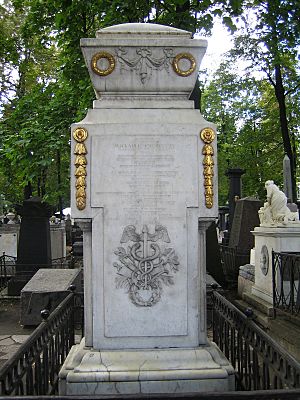
Lomonosov was proud to bring back the old art of mosaics. In 1754, he wrote that his experiments on how minerals affect colors led him to mosaic art. In 1763, he opened a glass factory. This factory made the first stained glass mosaics outside of Italy.
About forty mosaics are linked to Lomonosov, and twenty-four of them still exist today. Some of the most famous are a portrait of Peter the Great and the Battle of Poltava. The Battle of Poltava mosaic is very large, measuring about 4.8 by 6.4 metres (16 ft × 21 ft).
Grammarian, Poet, and Historian
In 1755, Lomonosov wrote a grammar book. This book changed the Russian literary language by mixing old church language with everyday speech. To support his ideas about literature, he wrote more than 20 formal poems called odes. A famous one is the Evening Meditation on God's Grandeur.
He had a unique theory for his later poems. He believed that gentle topics needed words with certain vowel sounds (like E, I, Y, and U). But scary things (like "anger" or "pain") needed words with different vowel sounds (like O, U, and Y). This was an early idea of what is now called sound symbolism.
In 1760, Lomonosov published a History of Russia. He also tried to write a long epic poem about Peter the Great. It was meant to be like the Aeneid by Vergil, but he died before he could finish it.
His Lasting Legacy
Lomonosov's granddaughter, Sophia Konstantinova, married a Russian military hero, General Nikolay Raevsky. His great-granddaughter was Princess Maria (Raevskaya) Volkonskaya.
Many places and things are named after Lomonosov:
- The city of Lomonosov, Russia (formerly Oranienbaum).
- A crater on the Moon and a crater on Mars.
- The asteroid 1379 Lomonosowa.
- A Russian satellite launched in 2016, named Mikhailo Lomonosov.
- The Imperial Porcelain Factory, Saint Petersburg was named after him for many years.
- The underwater Lomonosov Ridge in the Arctic Ocean.
- Lomonosov Bridge in Saint Petersburg.
- Domodedovo airport in Moscow.
- The Lomonosov Gold Medal, awarded every year to scientists.
- Lomonosovskaya Station in the Saint Petersburg Metro.
- A street in Riga, Latvia, called "Lomonosova iela."
- Many schools and universities, including Moscow State University, which he founded.
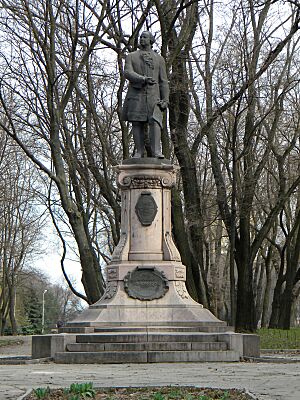
In Dnipro, Ukraine, a statue honoring Lomonosov stood for many years. It was removed in January 2023.
On November 19, 2011, Google celebrated his 300th birthday with a special Google Doodle.
Many postage stamps have been issued to honor Lomonosov over the years. These stamps show him and important places related to his life.
- Postage stamps of USSR and Russia
The Akademik Lomonosov, a floating nuclear power station, is also named after him.
The USSR State Bank issued a special coin in 1986 to celebrate his 275th birthday.
- Commemorative coins of Russia depicting Lomonosov
See also
 In Spanish: Mijaíl Lomonósov para niños
In Spanish: Mijaíl Lomonósov para niños
- Christian Wolff (philosopher)
- Dmitry Ivanovich Vinogradov
- Franz Aepinus
- Gerhard Friedrich Müller
- Ivan Kulibin
- Jean-Baptiste Chappe d'Auteroche
- Johann Daniel Schumacher
- Joseph-Nicolas Delisle
- Northern (Arctic) Federal University
- Stepan Krasheninnikov
- Stepan Rumovsky
- Vasily Trediakovsky


